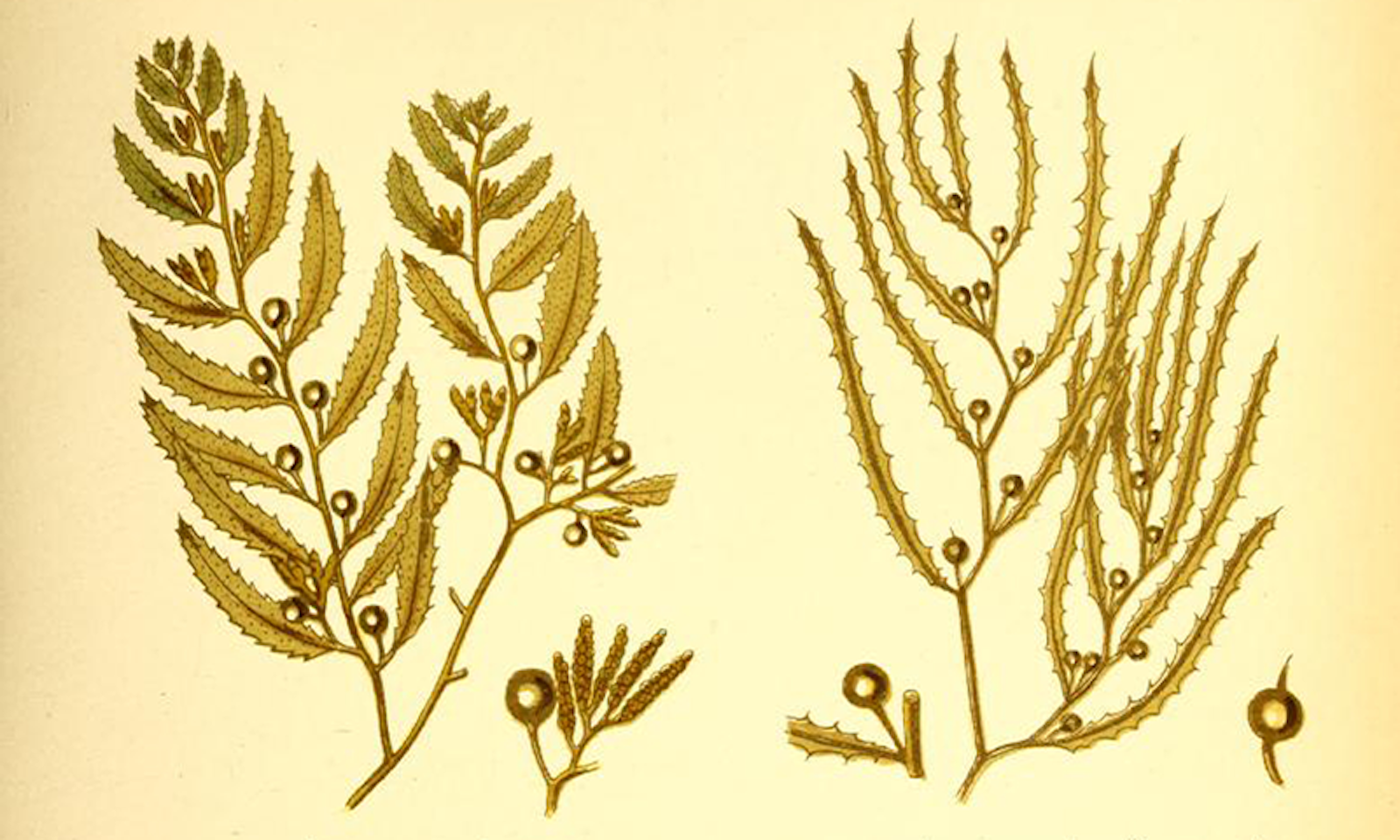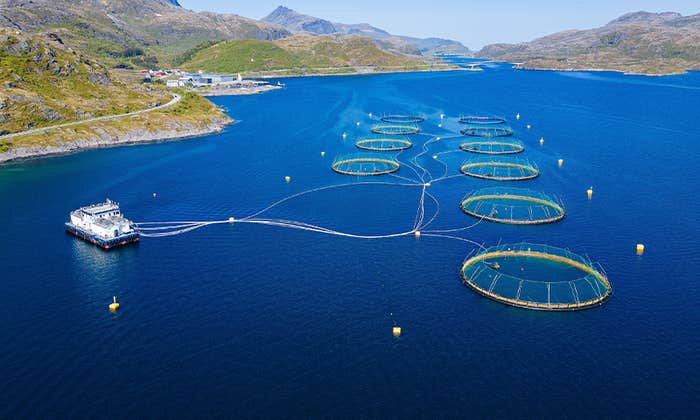On July 6, 1901, Natalie Karsakoff took a break from her busy schedule to write a letter to her mentor, the French botanist Édouard Bornet. Hoping he would join her on the northwest coast of France, she couldn’t help but boast a bit about where she was staying: the home of her good friend Anna Vickers.
Their lodging had everything a summer vacationer needed, she wrote: “a magnificent laboratory, well-lit, clean,” with “a stove to heat ones feet,” “blinds to sift the light,” and, of course, “tiled floor that could handle any liquid.” Right outside was the main attraction: a shore populated with what would eventually prove to be hundreds of species of algae, swaying underwater and waiting to be found.
Karsakoff and Vickers, whose story is detailed in a fascinating paper by science historian Emily S. Hutcheson, were devoted algologists. For 12 summers, from 1889 to 1901, they lived together at Vickers’ house in Roscoff, France, “revel[ing] among Chylocladias, Myrrotrichias, Callophyllis, Callithamnions, and Polysiphonias,” as Karsakoff wrote in another letter. They pushed the unlikely tradition of female seaweed experts to new levels. And they did all this within a stone’s skip of the Station Biologique De Roscoff, a research institute where other marine enthusiasts, mostly men, pursued similar interests in very different ways.
The Seaweed Craze
In the 19th and early 20th centuries, a fervor for natural history swept Europe. In Victorian England especially, this general enthusiasm crested into fads, often centered around collecting and arranging specimens, and enabled by changes in infrastructure and technology and increasing democratization of science. As historian Stephen Hunt told Atlas Obscura, working-class people and aristocrats alike used their expanding leisure time to hop trains out to the seashore or countryside, gather specimens, and examine them under increasingly affordable microscopes or present them at the next meeting of their local natural history club.
Their lodging had everything a summer vacationer needed: a magnificent laboratory …
One of these trends was the “seaweed craze.” According to the historian David Elliston Allen, European algae mania began in London in the 1750s when a merchant and botanist named John Ellis created a fanciful miniature seascape out of frondy specimens that ended up impressing the Princess Dowager of Wales. Within a century, the United Kingdom’s shorelines were thronged with excited splashers wielding, in the words of famed 19th-century seaweeder and author Margaret Gatty, “a basket, a bottle, a stick, [and] a strong pair of boots.”
Women were in on it from the beginning. (Ellis got his specimens from his sister in Dublin—behind every great man is a woman sending him seaweed in the mail.) But over time, sea plants emerged as a unique locus of opportunity for female natural historians, who were barred from major scientific societies and discouraged from supposedly unseemly pursuits like chasing animals and dissecting the sex organs of land plants. Plus, many were at the shore already, attempting to restore their health through sand promenades and breathing salty air.

Women who caught the seaweeding bug tried to spread the word to other women. Gatty—who picked it up in East Sussex, where she was healing after her seventh childbirth—used much of the introduction of her 1872 book British Sea Weeds to speak to what she calls her “sisterhood,” hoping to bring them out to the tideline and give them the opportunity to see and feel what she had. She offered fashion advice (“let woollen be in the ascendant as much as possible; and let the petticoats never come below the ankle”) and, perhaps more importantly, a pep talk. “You are in the right dress at the right place,” she wrote, “… free, bold, joyous, monarch of all you survey, untrammelled, at ease, at home! At home, though among all manner of strange, unknown creatures, flung at your feet every minute by the quick succeeding waves.”
Soon, a kind of subculture sprouted. Some women collected with their husbands (one male naturalist wrote about how his wife used a “larger muff than the present fashion would commend” to smuggle their seaweeding equipment offshore). Others collaborated with male scientists, who folded their samples into published work. Still others focused on the creation of public-facing natural history works, or of incredible aesthetic objects—including the first book ever illustrated with photographic images, Anna Atkins’s 1843 Photographs of British Algae, and vivid scrapbook albums of real specimens that are still collected and used in scientific research today.
The Central Bureau
Across the channel in Roscoff, and decades after some of their predecessors, Karsakoff and Vickers waded into algology from a slightly different place. Karsakoff, who was born in Russia and educated in France, had formal scientific training from the Sorbonne and experience working at Moscow State University. Although Vickers didn’t have this training, family wealth had afforded her other opportunities—to “study botany through collecting” while traveling, and to buy an oceanfront house in Roscoff and outfit it with lab space and supplies, Hutcheson writes. They had the support of male mentors like Bornet and less angst about, as Karsakoff put it, “[running] about the beach and among the rocks dressed as a guy.” Neither was married.
They also had different goals for their work than some of the women who came before. Rather than making scrapbooks or public-facing guides, the two spent their summers pursuing scientific papers and compiling a florule: a Who’s Who of seaweeds and other algae growing in this hyperdiverse slice of shoreline.
But as Hutcheson argues in her account, these scientifically ambitious women kept something in common with Gatty’s seaweed sisterhood. They thrived in, and needed, community. When Karsakoff first came to Roscoff in 1889, she was intrigued by the presence of the Station Biologique, but intimidated by its formality. Even if she had wanted to study or work there, it would have been difficult. Lodging was only offered to men.
They “interpreted the natural world as a place of mutual support.”
Karsakoff and Vickers met during her initial visit, and bonded over their shared love of algae. That summer, Karsakoff started working with Vickers and staying in her home. Decades before Virginia Woolf published “A Room of One’s Own,” Vickers gave Karsakoff “not only a lovely bedroom but a cabinet de travail or laboratory all to yourself,” Karsakoff wrote.
Both also got something more: “the delight of being mad as a pack of March hares” while combing the beach, wrote Karsakoff, with “devoted friends to help in the spreading and drying so as to enable you to look at the microscope and enjoy yourself.” Over the course of their dozen summers, the two invited other women with similar interests to join them (sometimes along with their mothers, who served as chaperones).
During the rest of the year, if they traveled to other shores, they tried to arrange meetups: Everything always went better with “two people mad together over the dredging, drying, etc.” as Karsakoff wrote to another algal enthusiast in 1897, attempting to convince her to join Vickers in Naples. Eventually, the pair’s dedication to building up these networks made Karsakoff feel as though she, herself, was “gradually becoming a central bureau in feminine algology.”
Symbiosis
This method of working gave Vickers and Karsakoff a different view of their subject matter—from the seaweeding women who came before, but also from the mostly male scientists working nearby at the Station Biologique, Hutcheson notes. While the station focused on lab work and individual specimens, the women’s florule sought to place every species properly in its environment and to understand where different marine plants grew and thrived, whether atop exposed rocks or deep beneath the waves.

Although noting which species could be found where had always been important to collectors, the idea that this had biological importance was just beginning to gain steam. And while that era’s mainstream theories focused on violence and competition between species, Karsakoff and Vickers “interpreted the natural world as a place of mutual support,” Hutcheson writes, like the working and living spaces they had built.
According to Hutcheson this is most noticeable in a paper Karsakoff published in 1892, describing the lives of small, fluffy brown algae in the genus Myriotrichia. Members of Myriotrichia grow epiphytically, perched on top of other underwater plants. At the time, close associations between species were often viewed as rivalrous, if not outright parasitic. But Karsakoff describes the algae as harmless tufts, which simply “take their share of heat and sunlight” without harming their hosts—just as she herself enjoyed the heat of Vickers’ foot stove, and the sunlight filtering through the laboratory blinds. Today, mutualistic relationships like the one Karsakoff recognized are seen as pillars of the ecosystems they are part of.
Despite years of work, Vickers and Karsakoff were never able to publish their florule themselves. Vickers died unexpectedly in 1906, when she was 54, leaving behind collections from a trip to Barbados, which other female collaborators eventually published. In 1954, her and Karsakoff’s Roscoff research was swept into a larger species inventory done by the Station Biologique, where some of their specimens still reside. Others are in Harvard University’s Farlow Herbarium.
But perhaps the best representation of their working relationship doesn’t come from Roscoff at all. In 1896, Karsakoff described and named a new genus of algae that Vickers had found in the Canary Islands, in a paper she published in Annales des Sciences Naturelles. In the paper’s accompanying illustration, the algae, branched and overlapping and filamentous, stretches like an umbrella over Karsakoff’s name and the name she gave the species: Vickersia canariensis. ![]()
Lead image: Biodiversity Heritage Library






































